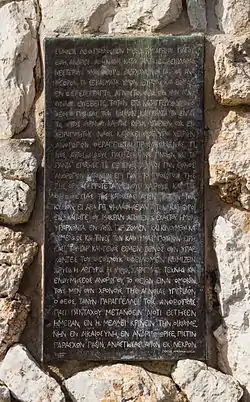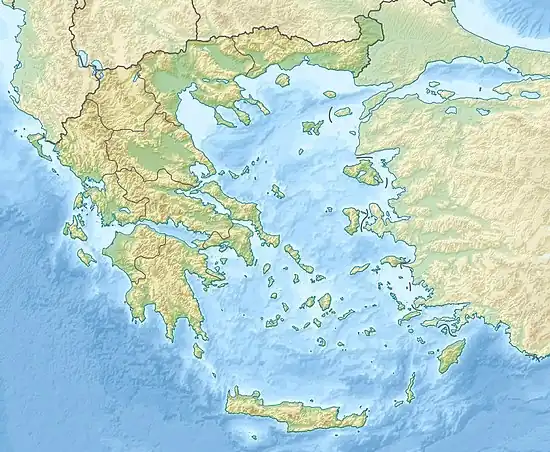Acts 17
Acts 17 is the seventeenth chapter of the Acts of the Apostles in the New Testament of the Christian Bible. It records the second missionary journey of Paul, together with Silas and Timothy. The book containing this chapter is anonymous, but early Christian tradition uniformly affirmed that Luke composed this book as well as the Gospel of Luke.[1]
| Acts 17 | |
|---|---|
 Bronze plaque dedicated to the visit of apostle Paul to the Areopagus Hill in Athens. It cites the text of Acts 17:22–32. Image taken in 2016. | |
| Book | Acts of the Apostles |
| Category | Church history |
| Christian Bible part | New Testament |
| Order in the Christian part | 5 |
Text
The original text was written in Koine Greek and is divided into 34 verses.
Textual witnesses
Some early manuscripts containing the text of this chapter are:
- In Greek
- Codex Vaticanus (AD 325–350)
- Codex Sinaiticus (330–360)
- Codex Bezae (c. 400)
- Codex Alexandrinus (400–440)
- Papyrus 127 (5th century; extant verses 1–10)[2]
- Codex Laudianus (c. 550)[3]
- In Latin
- Codex Laudianus (~550; complete)[3]
- León palimpsest (7th century; 1–25)[4]
Locations

This chapter mentions the following places (in the order of appearance):
Timeline
The second missionary journey of Paul took place in c. AD 49.[5]
Distances
The distance from Philippi to Amphipolis is about 33 miles (53 km) by Via Egnatia (which length was over 500 miles (800 km) from Hellespont to Dyrrhachium[6]) and further on this road from Amphipholis to Apollonia in the district of Mydonia is about 30 miles (48 km), then 37 miles (60 km) from Apollonia to Thessalonica,[7] as noted in Antonine Itinerary.[8] From Thessalonica to Berea (modern Veria) is about 80 kilometres (50 mi) westward.[9] Paul then traveled to 'the sea', which would have been at least 42 km at the nearest point, and then south to Athens, approximately 300 km (most likely by sea, though it is possible that he walked the coastal road instead). The journey 'by night' from Thessalonica to Berea (Acts 17:10) presumably took more than one night.
In Thessalonica (17:1–9)
Paul, Silas and Timothy continued the travel westward from Philippi on Via Egnatia, passing several cities before arriving at Thessalonica, which has a 'well-established Jewish community with a synagogue' (verse 1), where Paul visited for three successive sabbaths speaking about the gospel (verse 2).[10] After an initial success among synagogue members extending to the receptive Gentile adherents (verse 4), an outbreak of 'jealousy' (or 'fundamentalist zeal': zelosantes, verse 5) occurred within 'the Jews', who took the city mob to launch an attack on Paul and Silas.[9] When Paul and Silas could not be found, the mob took a man named "Jason", as one of Paul's followers, to the civic authorities (called politarchs in verse 6; a title attested in inscriptional evidence for Thessalonica[11] with a charge of disturbance (verses 6–7)[9] that Paul's teaching of "the Kingdom" (cf. Acts 28:31) was 'inherently incompatible with the personal oaths of loyalty to the emperor' as 'demanded of all inhabitants of the empire'.[12]
In Berea (17:10–15)
Paul's mission was initially dependent on 'the networks of the Jewish diaspora', that very time he arrived in an unfamiliar city, Paul first visited a synagogue to preach the gospel among the Jewish people. The Jews in Berea were noted as "more noble" (Greek: eugenesteroi, v. 11: NRSV: "more receptive"), as they were willing to give a 'careful and open-minded examination' (Greek: anakrinontes, v. 11) of Paul's teaching, before many of them came to belief (verse 12).[9] There is a contrast between "women of high standing and men" who believe (verse 12) and "the crowds" ('the urban proletariat'), who were agitated by the Jews of Thessalonica (verse 13).[9]
In Athens (17:16–21)
The absence of any mention of places between Berea and Athens provides presumptive evidence that Paul indeed travel by sea, 'rounding the promontory of Sunium, entered Athens by the Piræus'.[13] That he spent some time waiting in Athens (verse 16) is confirmed by 1 Thessalonians 3:1–6, which must have been written not long after this time.[9] The philosophical scene (verse 18) was reminiscent of the classical period in Athens, when Socrates engaged in philosophical dialogue (Greek: dielegeto, "argued', verse 17) in the streets and agora of Athens, and the charge against Paul about proclaiming "foreign divinities" (Greek: xenon daimonion, verse 18) would remind the charge brought against Socrates of preaching "new divinities" (Greek: kaina daimonia: cf. Xenophon, Memorabilia 1.1.1–4; only here in the New Testament that daimonia has the neutral Greek sense 'divine beings' instead of 'evil spirits').[9] The Areopagus was the chief administrative body at that time in Athens.[14]
Verse 18
- Then certain Epicurean and Stoic philosophers encountered him. And some said, "What does this babbler want to say?"
- Others said, "He seems to be a proclaimer of foreign gods," because he preached to them Jesus and the resurrection.[15]
Epicureans and Stoics are from two most dominant and popular schools of philosophy in Athens at that time (more than Academics and Peripatetics) and also with the greater contrast of teachings with the doctrines of Christianity, that Paul preached ("encountered" or "in conflict with", from Greek: συνέβαλλον, syneballon; cf. Luke 14:31).[16]
- "Babbler": translated from Greek: σπερμολογος, spermologos literally "seed-picker", figuratively "one who picks up scraps of knowledge".[17]
Addressing the Areopagus (17:22–34)
.jpg.webp)
The speech, known as the Areopagus sermon, refers to a sermon or explanation delivered by Apostle Paul at the Areopagus in Athens, and described in Acts 17:16–34.[18][19] The Areopagus sermon is the most dramatic and fullest reported speech of the missionary career of Saint Paul and followed a shorter address in Lystra Acts 14:15–17.[20] Paul explained concepts such as the resurrection of the dead and salvation, in effect a prelude to the future discussions of Christology. According to the record, after the sermon, a number of people became followers of Paul. These included a woman named Damaris, and Dionysius, a member of the Areopagus. This latter has at times been suggested as Dionysius the Areopagite, but that may be a historical confusion.[21]
Verse 28
- for in Him we live and move and have our being, as also some of your own poets have said, 'For we are also His offspring'.[22]
- "For in Him we live and move and have our being": is quoted from Cretica (Κρητικά) by Epimenides as found by J. Rendel Harris based on a 9th-century Syriac commentary by Isho'dad of Merv on the Acts of the Apostles.[23]
- "'For we are also His offspring'": Paul might take this quotation from two poets:[13]
- Aratus, probably of Tarsus[13] or Soli in Cilicia[16] (~272 BC), thus Paul's countryman. The words τοῦ γὰρ καὶ γένος ἐσμέν ("For we too are his offspring") are found in a didactic poem titled "Phenomena", comprising the main facts of astronomical and meteorological science at that time, starting with an invocation to Zeus.[13][16][lower-alpha 1]
- Cleanthes (~300 BC), of Assos in Mysia, who wrote ἐκ σοῦ γὰρ γένος ἐσμέν ("For we thine offspring are") in a hymn to Zeus.[13][16][lower-alpha 2]
See also
Notes
-
- "From Zeus begin; never let us leave
- His name unloved. With Him, with Zeus, are filled
- All paths we tread, and all the marts of men;
- Filled, too, the sea, and every creek and bay;
- And all in all things need we help of Zeus,
- For we too are his offspring."
- —Aratus, Phænomena 1–5. Cited in Ellicott's Bible Commentary for English Readers. Acts 17.
-
- "Most glorious of immortals, many-named,
- Almighty and for ever, thee, O Zeus,
- Sovran o’er Nature, guiding with thy hand
- All things that are, we greet with praises. Thee
- ’Tis meet that mortals call with one accord,
- For we thine offspring are, and we alone
- Of all that live and move upon this earth,
- Receive the gift of imitative speech."
- —Cleanthes, Hymn to Zeus. Cited in Ellicott's Bible Commentary for English Readers. Acts 17.
References
- Holman Illustrated Bible Handbook. Holman Bible Publishers, Nashville, Tennessee. 2012.
- Continuation List Institute for New Testament Textual Research, University of Münster. Retrieved March 29, 2010
- Aland, Kurt; Aland, Barbara (1995). The Text of the New Testament: An Introduction to the Critical Editions and to the Theory and Practice of Modern Textual Criticism. Erroll F. Rhodes (trans.). Grand Rapids: William B. Eerdmans Publishing Company. p. 110. ISBN 978-0-8028-4098-1.
- Bruce M. Metzger, The Early Versions of the New Testament, Oxford University Press, 1977, p. 316.
- John Arthur Thomas Robinson (1919–1983). Redating the New Testament. Westminster Press, 1976. 369 pages. ISBN 978-1-57910-527-3
- Horace, Satires i., 5, 97; apud Nicoll, Expositor's Greek Testament on Acts 17.
- Moule, H. C. G., Cambridge Bible for Schools and Colleges. Acts 17. Accessed 28 April 2019
- Nicoll, W. R., Expositor's Greek Testament. Acts 17. Accessed 24 April 2019.
- Alexander 2007, p. 1050.
- Alexander 2007, pp. 1049–1050.
- Horsley, G. H. R. (1994), The Politarchs, in Gill and Gempf (1994), pp. 419–431; apud Alexander 2007 p. 1050.
- Barrett, C. K. (1994–9), The International Critical Commentary: Acts (2 vols.; Edinburgh: T. & T. Clark). ii. pp. 815–816; apud Alexander 2007 p. 1050.
- Ellicott, C. J. (Ed.) (1905). Ellicott's Bible Commentary for English Readers. Acts 17. London : Cassell and Company, Limited, [1905–1906] Online version: OCLC 929526708. Accessed 28 April 2019.
- Gill, D. (1994), Achaia, in Gill and Gempf (1994) (eds.), The Book of Acts in its First Century Setting, ii. Graeco-Roman Setting (Grand Rapids: Eerdmans), p. 447; apud Alexander 2007, p. 1050
- Acts 17:18 NKJV
- Meyer, Heinrich August Wilhelm (1880). Commentary on the New Testament. Acts 17. Translation by Peter Christie from Meyer's sixth edition. Accessed February 14, 2019.
- Strong's Concordance. 4691. Spermologos. Biblehub.com
- Christianity: an introduction by Alister E. McGrath pp. 137–141, 2006, ISBN 1-4051-0901-7
- Theology of the New Testament by Udo Schnelle (2009) ISBN 0801036046 p. 477
- Mercer Commentary on the New Testament by Watson E. Mills 2003 ISBN 0-86554-864-1 pp. 1109–1110
- Paul: A Brief History by Robert Paul Seesengood 2010 ISBN 1-4051-7890-6 p. 120
- Acts 17:28 NKJV
- Harris, J. Rendel. "A Further Note on the Cretans", Expositor Apr. 1907, 332–337. Quote:
- J. Rendel Harris' hypothetical Greek text:
Κρῆτες, ἀεὶ ψευδεῖς, κακὰ θηρία, γαστέρες ἀργαί.
Ἀλλὰ σὺ γ᾽ οὐ θνῇσκεις, ἕστηκας γὰρ ζοὸς αίεί,
Ἐν γὰρ σοὶ ζῶμεν καὶ κινύμεθ᾽ ἠδὲ καὶ ἐσμέν.- Translation:
Cretans, always liars, evil beasts, idle bellies.
But you are not dead: you live and abide forever,
For in you we live and move and have our being.
Sources
- Alexander, Loveday (2007). "62. Acts". In Barton, John; Muddiman, John (eds.). The Oxford Bible Commentary (first (paperback) ed.). Oxford University Press. pp. 1028–1061. ISBN 978-0199277186. Retrieved February 6, 2019.
- Coogan, Michael David (2007). Coogan, Michael David; Brettler, Marc Zvi; Newsom, Carol Ann; Perkins, Pheme (eds.). The New Oxford Annotated Bible with the Apocryphal/Deuterocanonical Books: New Revised Standard Version, Issue 48 (Augmented 3rd ed.). Oxford University Press. ISBN 9780195288810.
External links
- Acts 17 King James Bible – Wikisource
- English Translation with Parallel Latin Vulgate
- Online Bible at GospelHall.org (ESV, KJV, Darby, American Standard Version, Bible in Basic English)
- Multiple bible versions at Bible Gateway (NKJV, NIV, NRSV etc.)
